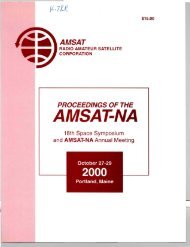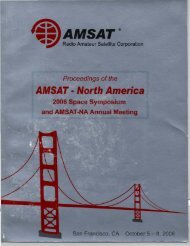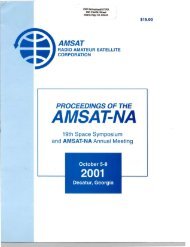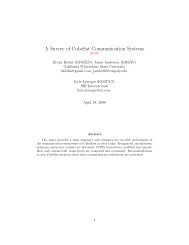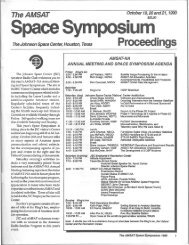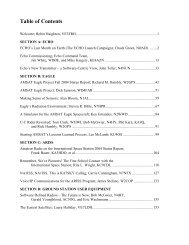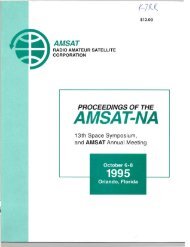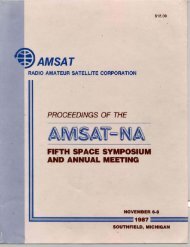November 8-10, 1991 - Klofas.com
November 8-10, 1991 - Klofas.com
November 8-10, 1991 - Klofas.com
You also want an ePaper? Increase the reach of your titles
YUMPU automatically turns print PDFs into web optimized ePapers that Google loves.
The present method of imaging therefore concentrates efforts<br />
in this equatorial band where the probability of favorable attitude<br />
is greatest. In addition, solar array constraints are also used to<br />
determine the orientation of the satellite, as the horizon sensor<br />
data alone is sometimes "noisy". Most importantly, operators have<br />
now bracketed the proper iris settings which seem to provide the<br />
best earth images. These changes have resulted in roughly a 40%<br />
success rate as opposed to around 1% for the old system.<br />
Problems & Fixes<br />
Many of the early photos from the Webersat camera were over or<br />
under exposed, seemingly regardless of the automatic iris control.<br />
Numerous attempts at manually <strong>com</strong>manding the iris size, and<br />
searching for possible software problems yielded no clues. A<br />
careful analysis of the on-orbit conditions proved helpful:<br />
With 1.41x<strong>10</strong>5 lux of Solar illumination at earth's orbital<br />
radius, and an average earth albedo of .39, the normal illumination<br />
seen by Webersat when observing the earth is 5.5x<strong>10</strong>4 lux.<br />
The camera has a standard sensitivity of 200 lux at an<br />
aperture diameter of F/2.8, or 8.9mm. This means that an aperture<br />
of roughly F/46. 5 or .538mm diameter is required for earth<br />
observation. This is a rather small aperture for a camera iris<br />
system originally intended for general industrial applications<br />
where standard steps range from F/2 to F/22. The problem seemed<br />
clear: The auto-iris control couldn't ac<strong>com</strong>modate the small<br />
aperture needed. A time delay feature was added to the next<br />
version of the software, allowing the camera to take pictures as<br />
the iris opened from full closure which the iris was known to do on<br />
power-up. This partial fix improved results, and permitted a<br />
number of excellent shots to be taken during the summer of 1990.<br />
However, results were not easily duplicated even with the same<br />
delay and nominal iris settings.<br />
System characteristics remembered from ground tests, and<br />
considerable experimentation with delay values finally yielded<br />
another idea: The auto-iris was indeed working, but required much<br />
more time to step down to the aperture called for, it being so<br />
narrow.<br />
By increasing the settling delay time by a factor of <strong>10</strong>0, and<br />
using what has been found to be nominal iris size values,<br />
repeatable, high quality earth images are now being produced.<br />
More Questions<br />
Several long-term observations have raised additional<br />
questions about Webersat and its camera system. In particular, it<br />
has been noted over the past year and a half that the vast majority<br />
38



